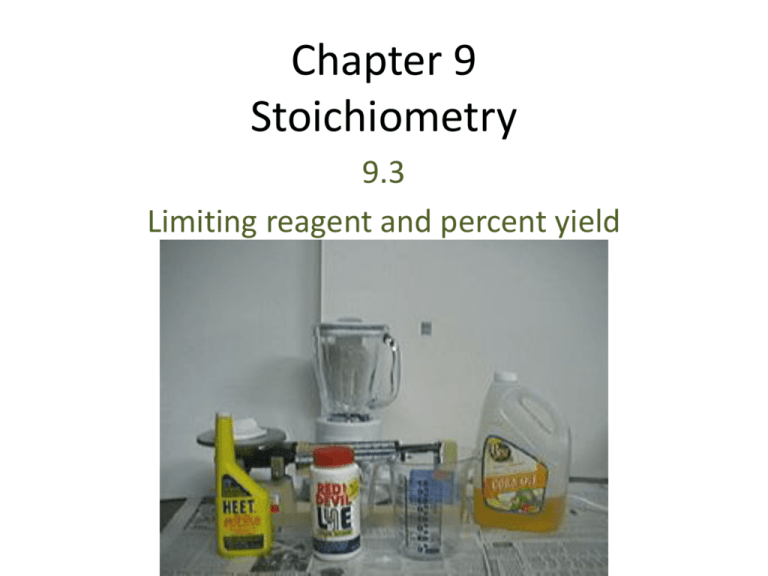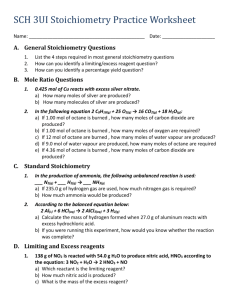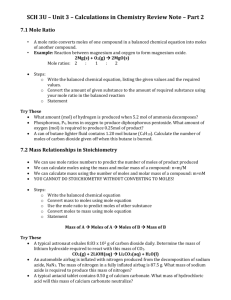Chapter 9 Stoichiometry
advertisement

Chapter 9 Stoichiometry 9.3 Limiting reagent and percent yield Things you will learn • You will be able to determine what the limiting reactant in a chemical reaction is and what the excess reactant is. • You will be able to calculate percent yield from a theoretical yield and an actual yield. • Chocolate Chip Cookie Ingredients • • 3/4 cup sugar • 3/4 cup packed brown sugar • 1 cup butter, softened • 2 large eggs,beaten • 1 teaspoon vanilla extract • 2 1/4 cups all-purpose flour • 1 teaspoon baking soda • 3/4 teaspoon salt • 2 cups semisweet chocolate chips • if desired, 1 cup chopped pecans, or chopped walnuts This recipe makes 16 cookies • Chocolate Chip Cookie Ingredients • • 3/4 cup sugar • 3/4 cup packed brown sugar • 1 cup butter, softened • 2 1 large egg, beaten • 1 teaspoon vanilla extract • 2 1/4 cups all-purpose flour • 1 teaspoon baking soda • 3/4 teaspoon salt • 2 cups semisweet chocolate chips • if desired, 1 cup chopped pecans, or chopped walnuts Limiting reagent • In this case, the whole recipe must be scaled back by 50%, and the yield will only be 8 cookies • Eggs are the limiting reagent (reactant) A balanced chemical equation is a recipe. If there is a part of the ingredients which is less than what the recipe calls for, there will be less product and excess reactants which can’t combine with other things. In this reaction, H2 an O2 combine to form water. The balanced reaction is: 2H2 + O2 2H2O H2 is the limiting reagent N2(g) + 3H2(g) 2NH3(g) The mole ratios are: 1 mole N2 2 moles NH3 3 moles H2 2 moles NH3 1 mole N2 3 moles H2 2 moles NH3 1 mole N2 2 moles NH3 3 moles H2 3 moles H2 1 mole N2 N2(g) + 3H2(g) 2NH3(g) • If you have less than 1 mole of nitrogen, or less than 3 moles of hydrogen, you won’t get 2 moles of ammonia N2(g) + 3H2(g) 2NH3(g) • You have 2 moles of N2 and 2 moles of H2. – What is the limiting reagent? – How much ammonia will this reaction yield? N2(g) + 3H2(g) 2NH3(g) • You have 2 moles of N2 and 2 moles of H2. – What is the limiting reagent? – Choose one reactant arbitrarily and plug it into the equation: 2 mol N2 3 mol H2 1 mol N2 6 mol H2 H2 is the limiting reagent because we would need 6 moles of it to react with 2 moles N2 N2(g) + 3H2(g) 2NH3(g) • You have 2 moles of N2 and 2 moles of H2. – How much ammonia will this reaction yield? – Plug the limiting reagent into the equation with the mole ratio of the product limiting reagent 2 mol H2 2 mol NH3 3 mol H2 1.33 mol NH3 2Cu + S Cu2S • You have 80 g CU and 25 g S – What is the limiting reagent? – What is the maximum amount of Cu2S yielded? 2Cu + S Cu2S • You have 80 g CU and 25 g S – What is the limiting reagent? – 80 g Cu is 1.26 mole Cu – 25 g S is .78 mole S – Choose one reactant arbitrarily and plug it into the equation: 1.26 mol Cu 1 mol S 2 mol Cu .63 mol S We have more than .63 mole S, so Cu is the limiting reagent 2Cu + S Cu2S • You have 80 g CU and 25 g S – What is the maximum amount of grams of Cu2S produced? – Plug the limiting reagent into the equation with the mole ratio of the product limiting reagent 1.26 mol Cu 1 mol Cu2S 2 mol Cu .63 mol Cu2S The molar mass of Cu2S is 159 g, so the yield of Cu2S is .63 mol x 159 g/mol Cu2S = 100.2 g Cu2S Percent yield • Actual yield / theoretical yield X 100% • Duh!!





